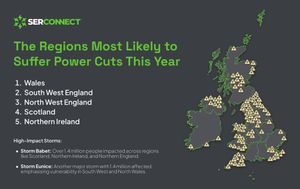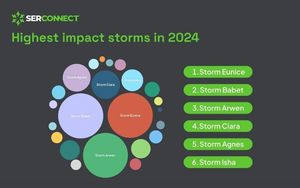Storm data reveals top UK regions most at risk of power cuts
As many across the country have experienced, storms can cause major disruption within day-to-day life, and even have the potential to significantly harm individuals. As a result of the strong winds, roads can become blocked by fallen trees, flooding can damage buildings and access to essential services can be affected.

With the many storms that have had detrimental effects on the UK in previous years, Independent Connection Providers (ICP) Serconnect has taken a closer look at the effects with a comprehensive survey. Using data provided by the Met Office, it has revealed which areas are most susceptible to power cuts caused by storms and require the most preparation to prevent the effects of these.
Neil McKillo, Managing Director at Serconnect, says: “Storms can have a detrimental effect on many individuals around the country, leaving many without power due to sudden cuts. So, it’s important that households and businesses are well prepared and in the know on how to best deal with any problems that may arise from a power cut, and how to protect themselves and their property before repairs are carried out.”
The detrimental effect of storms

As many across the country have experienced, storms can cause major disruption within day-to-day life, and even have the potential to significantly harm individuals. As a result of the strong winds, roads can become blocked by fallen trees, flooding can damage buildings and access to essential services can be affected.
One of the most common disruptions caused by flooding is power cuts. These can result for many reasons, with strong winds causing power lines to sway and break connections or trees to fall on power lines. Floods caused by storms can also cause electrical systems to short-circuit and systems to shut down through damage to underground cables and substations.
These power cuts can have an effect on a significant number of people. Notably, Storm Babet affected over 1.4 million people across regions such as Scotland, Northern Ireland, and Northern England. Additionally, Storm Eunice was another major storm that also caused 1.4 million to experience power cuts, which highlighted vulnerability in South West and North Wales.
With some regions being more susceptible to power cuts than others, we discuss which are the ones that are most commonly affected and require the most preventative measures below.
The regions most affected by storms, in data
As a result of Serconnect’s survey, it’s been clearly outlined which regions across the UK have been most affected by power outages due to storms, and which are therefore most vulnerable.
Certain regions, such as Scotland, Northern Ireland, and Wales, are clearly more vulnerable to impact. This is because coastal regions are closest to storms that develop over the Atlantic Ocean in comparison to landlocked areas.
However, it’s not only coastal areas that can experience power cuts. Some areas that are prone to flooding, such as Yorkshire and the Midlands, can be affected by storm power cuts as a result of damage to underground electrical infrastructure. In addition, flooding can prevent engineers from accessing areas that require repair.
Furthermore, storm power cuts can particularly affect rural and northern counties, as some areas may have a less robust infrastructure than some other areas of the UK.
The seasonality of storms can affect their frequency. For example, winter and late-autumn periods have often seen higher storm activity, so the most severely affected regions must prepare accordingly during these months. For more specific advice, the best methods on how to act in the event of a storm power cut are detailed below.
How to survive a power cut as a business:
The above statistics demonstrate that millions of people across the UK have been severely affected by storm power cuts, with some regions being especially vulnerable to these. With this in mind, it’s important to know how to prevent any harm to individuals and damage to property that could arise as a result of a power cut. The most important things to bear in mind are:
Before a power cut
- Develop a contingency plan: Take the time to identify the core functions that must remain operational in the event of a power cut, and plan how you will mitigate the risks to staff’s safety and your business assets before one occurs.
- Using standby generators: In the event of a power cut, it’s essential that certain critical business functions remain operational. As a result, having a local company on standby who are experts in electrical installations to install a standby generator is worth considering. Having a maintenance and fault response agreement with them is also a worthwhile precaution.
- Keep up to date with storm reports. Stay informed of the latest storm reports, especially those named by the Met Office. This indicates that the storm has the potential to cause damage and disruption that will result in an amber or red warning. As a result, you can better prepare for how a storm could affect your business.
- Prepare an emergency kit: You should prepare an emergency kit for the event of a storm, or any other emergency scenario, which contains essential items. This should include supplies such as a first aid kit, emergency water and torches.
During a power cut
- Report the power cut: You should call your local network operator if your business has been affected by an unexpected power cut. Lines and infrastructure may be owned by a DNO, an IDNO or it may be a private network, so you should contact the corresponding owner in your area. If under a private network, you should contact your maintenance and fault response provider.
- Turn off equipment: You should turn everything that’s non-essential off, as this will prevent power surges that could damage your equipment.
- Prioritising health and safety: You should ensure that lighting and heating are prioritised in your building in the event of a power cut to keep yourself and your staff safe. Your staff should also be updated at all times as to how you plan to deal with the situation. If power cuts are extended, you should send your employees home if no work can be carried out, or evacuate them safely out of the building if required.
- Call 999 in case of emergency
After a power cut
- Restore power safely: Turn your equipment back on gradually, as this will prevent overloading the system.
- Check equipment for damages: During power cuts, your equipment may have been damaged or may now malfunction. Check to see if this is the case after a power cut before turning anything on to prevent any harm
- Review your response: If another power cut were to take place, is there anything else you could have done to be more prepared? Review your response to the power cut and take note of any improvements you can implement if another occurs.





